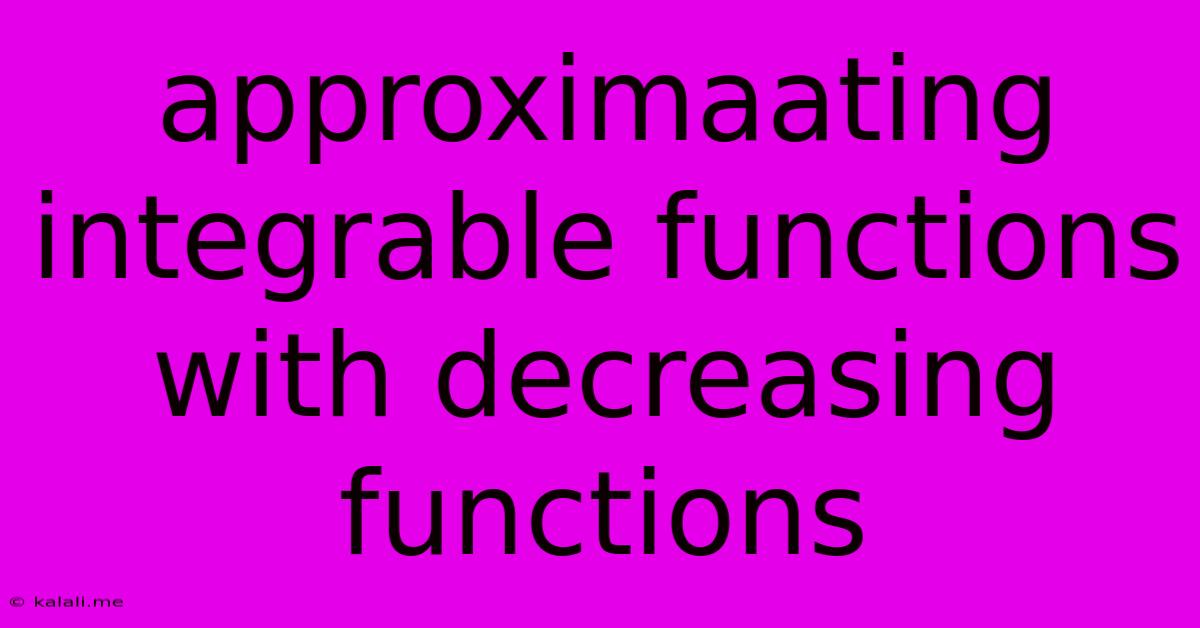Approximaating Integrable Functions With Decreasing Functions
Kalali
May 23, 2025 · 3 min read

Table of Contents
Approximating Integrable Functions with Decreasing Functions
This article explores the fascinating mathematical concept of approximating integrable functions using decreasing functions. Understanding this allows for simplification in certain integration problems and provides valuable insights into the behavior of integrable functions. We will delve into the methods and implications of this approximation technique. This process is particularly useful in areas like measure theory and functional analysis.
What are Integrable Functions?
Before diving into the approximation, let's clarify what we mean by an integrable function. An integrable function, in the context of Riemann integration (which we'll primarily focus on here), is a function whose definite integral exists. Intuitively, this means the area under the curve of the function is well-defined and finite over a given interval. There are various criteria for integrability, with the most common being that the function is bounded and continuous almost everywhere on the interval. Functions with discontinuities (like jump discontinuities or removable discontinuities) can still be integrable provided the discontinuities are "small" enough in a measure-theoretic sense.
Why Approximate with Decreasing Functions?
Decreasing functions possess a unique property that simplifies many mathematical operations, especially integration. Their monotonicity allows for easier manipulation and estimation of integrals. Approximating a more complex integrable function with a decreasing function can simplify the calculation of its integral or offer a tighter bound for its value. This is particularly helpful when dealing with functions that lack closed-form antiderivatives or when computational efficiency is a priority.
Methods for Approximation
Several methods exist to approximate integrable functions with decreasing functions. The choice of method often depends on the specific characteristics of the function being approximated. Some common approaches include:
1. Piecewise Constant Approximation
This involves dividing the domain of the integrable function into subintervals and approximating the function with a constant value within each subinterval. By choosing the constant value as the supremum of the function's values within the subinterval, we obtain a decreasing sequence of piecewise constant functions that approximate the original function from above.
2. Concave Envelope Approximation
For functions that exhibit a degree of concavity, constructing a concave envelope provides a decreasing approximation. The concave envelope is the pointwise supremum of all concave functions lying below the integrable function. This approach provides a good approximation, particularly if the original function is relatively smooth.
3. Using Step Functions
Step functions, which are piecewise constant functions with a finite number of steps, can effectively approximate integrable functions. By carefully selecting the height and width of the steps, a decreasing step function can be constructed that bounds the integrable function from above. The integral of the step function then provides an upper bound for the integral of the original function.
Implications and Applications
Approximating integrable functions with decreasing functions has several implications and applications:
- Simplified Integration: The integral of a decreasing function is often easier to compute than the integral of a more complex function.
- Bounding Integrals: The approximation provides bounds for the integral of the original function, facilitating error analysis and estimations.
- Measure Theory: In measure theory, these approximations are crucial in understanding concepts like Lebesgue integration and convergence of functions.
- Numerical Analysis: These approximation techniques form the basis for many numerical integration methods.
Conclusion
Approximating integrable functions with decreasing functions offers a powerful technique for simplifying integration problems and gaining a deeper understanding of function behavior. The methods described above, while not exhaustive, provide a solid foundation for tackling such approximations. Further exploration into specific approximation techniques and their convergence properties will provide even greater insight into this valuable mathematical tool.
Latest Posts
Latest Posts
-
Absolute Continuity But Not Bounded Variation
May 23, 2025
-
Natlib Limit On Number Of Authors
May 23, 2025
-
Variable State Space In Reinforcement Learning
May 23, 2025
-
Do Presbyterians Believe In Replacement Theology
May 23, 2025
-
Is Attorneyt Generals Office Without The State Capitalized
May 23, 2025
Related Post
Thank you for visiting our website which covers about Approximaating Integrable Functions With Decreasing Functions . We hope the information provided has been useful to you. Feel free to contact us if you have any questions or need further assistance. See you next time and don't miss to bookmark.